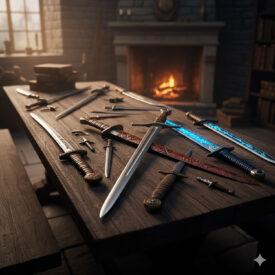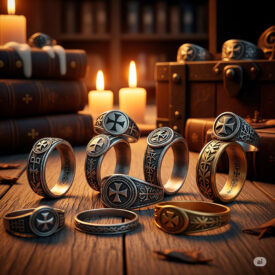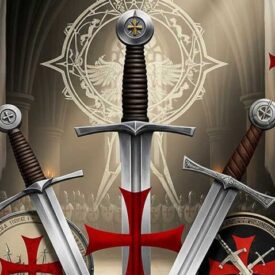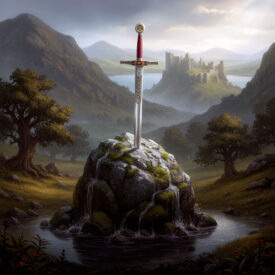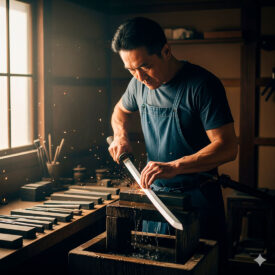Marto: a flame, a master, and the secret of tempering
What makes a sword a legend? It’s not just the shape of its blade or the beauty of its hilt; it’s the history imprinted in its steel, the hand that forged it, and the place where it was born. In the heart of Spain, Toledo has for centuries been synonymous with excellence in metallurgy. And if we talk about who has best preserved that tradition, the name Marto appears, a forger of historical replicas and guardian of the famous “Secret of Tempering.”
In this article, you will learn how tradition and technique intertwine in Marto swords, what distinguishes Toledo steel, what are its most relevant collections, how to choose a replica according to its use, and how to maintain it to preserve its epic presence for generations.
History, technique, and models will be presented with comparative data and practical examples so that you can decide with criteria, whether you are a collector, historical reenactor, or a lover of the sword as an artistic object.

Chronology: the route of steel from the medieval forge to Marto
The chronology shows the milestones that converge in Marto’s current production. Each date is a link that connects tradition, institutionalization, and international projection.
| Year / Period | Milestone | Relevance |
|---|---|---|
| Middle Ages | Development of tempering and forging in Toledo | Birth of the legend of Toledo steel; artisanal techniques transmitted orally |
| 15th-19th Centuries | Consolidation of sword-making workshops | Refinement of processes and international reputation |
| 1961 | Founding of Marto in the historic center of Toledo | Gathers and professionalizes local tradition, creating the Marto brand |
| Late 20th Century – 21st Century | “Made in Toledo” brand and international expansion | Certification of origin and projection at international fairs |
The forge behind the myth: what is the “Secret of Tempering”?
When the “Secret of Tempering” is mentioned, it refers to a tradition of artisans who, without modern measuring devices, managed to temper steel with exceptional results. This controlled tempering defined the flexibility, sharpness, and resistance of the blade. In simple words: it is the practical alchemy between fire, time, and technique.
Marto collects that tradition and merges it with contemporary processes when necessary. It is not about rigid anachronism, but a continuity with adaptations that guarantee quality and repeatability: the result is swords with a historical appearance and finishes that meet aesthetic and functional expectations.
This legacy holds three essential pillars: steel selection, controlled tempering, and finishing work by master swordsmiths. These pillars explain why the name of Toledo appears associated with swords recognized worldwide.
Marto’s Featured Collections and Models
Marto’s offering ranges from replicas of ancient swords —Roman, Visigothic, Templar— to pieces inspired by legends and historical figures. Each collection seeks to reflect a period, a style, and a function. Below you will see examples and how to choose according to your interest.
Emblematic Models
- Templar Sword (e.g., Marto 584.1): robust replica, Templar symbolism on the hilt, oriented to collection and historical exhibitions.
- Classic Medieval Replicas: double-edged swords, good balance for reenactment and display.
- Katanas and Oriental pieces: collection where Marto applies its experience to reinterpret Japanese techniques and aesthetics.

Technical Comparison: Marto vs. Typical Historical Swords
To understand in measurable terms what Marto contributes, it is convenient to compare typical specifications. The following table gathers useful data for collectors and reenactors.
| Characteristic | Typical Historical Sword | Marto Sword (e.g., Templar 584.1) |
|---|---|---|
| Blade length | 70-85 cm | Up to 117 cm (depending on model) |
| Weight | 900 g – 1.5 kg | 2.9 kg (robust Templar model) |
| Material | Carbon steel or combined | Certified Toledo steel/modern alloys |
| Recommended use | Historical combat/reenactment or collection | Collection, display, light reenactment |
| Finishes | Vary by workshop | Symbolic decoration and high-quality artistic details |
How to Choose a Marto Sword According to Your Intention?
Choosing the right sword depends on three factors: use, aesthetics, and budget. Although we will not indicate prices, we will offer practical criteria for deciding.
1) For collection and display
Look for models with artistic finishes, crafted hilts, and precise symbolism. Marto swords are designed to offer historical presence: ornate pommels, engravings, and sometimes pieces in noble metal or aged finishes.
2) For historical reenactment
Here, the balance of the blade, the robustness of the steel, and the fidelity to historical design matter. Models with historical measurements (blade length between 70 and 85 cm) and appropriate profiles work better in controlled practices.
3) For decorative use in themed environments
Attention to visual detail is key. If the sword will occupy a central place in a room or office, prioritize finishes and pieces with symbolism.
Remember that some Marto pieces, due to their robustness and weight, are more imposing than functional for combat; that choice is aesthetic and symbolic.

Maintenance and Preservation: How to Care for a Marto Sword
A well-cared for sword ages with nobility. The conservation guidelines are simple, but must be followed: humidity control, steel cleaning, and specific care for hilts and ornamental pieces.
- Steel cleaning: clean with a soft cloth and protective oil to prevent rust.
- Avoid humid environments: store in a dry and ventilated place.
- Inspection of rivets and hilt: check adjustment and firmness after use or handling.
- Protection of decorative elements: clean with suitable products for metals and avoid abrasives on engravings.
Production and Certification: “Made in Toledo”
Marto is not just a brand: it is the business manifestation of a tradition. The granting and use of the “Hecho en Toledo” (Made in Toledo) brand certifies the origin and ensures that the piece respects minimum local production standards. This seal arises from the coordination between the Toledo City Council, the University, and the Association of Swordsmiths, with the mission of protecting the tradition against industrial imitations without historical roots.
The company combines the work of master swordsmiths with development processes, quality control, and presentations for international markets. This synergy explains why Marto continuously participates in fairs and events where it presents collections and reaffirms its status as a reference.

Comparative Selection Table: Which Model to Choose Based on Profile?
| Profile | Key Features | Recommended Models |
|---|---|---|
| Visual Collector | High decorative detail, artistic finish, display packaging | Ornate Templar swords, replicas of kings’ swords |
| Historical Reenactor | Historical measurements, functional balance, resistant materials | Medieval swords with 70-85 cm blade, utilitarian replicas |
| Thematic Decoration | Visual impact, clear symbolism, optional imposing weight | Legendary swords, ceremonial mandobles |
Frequently Asked Questions Collectors Whisper to Themselves
Are Marto swords functional? Normally no, they are only oriented towards collection. Marto manufactures replicas for different purposes: exhibition, light reenactment, and collector’s pieces with artistic finishes. If functionality is a priority, it is advisable to verify specifications (type of steel, tempering, blade thickness).
What distinguishes a Marto sword from an industrial replica? The origin, the finishing work by artisans, and the tradition: Marto relies on Toledo techniques and quality controls to maintain a product with identity.
The Intangible Value: Symbolism and Stories Accompanying the Steel
A sword is not just metal; it is a narrative. Marto swords incorporate iconographies —crosses, fleur-de-lis, medieval motifs— that evoke orders, kings, and myths. That symbolic dimension is what transforms an object into emotional heritage. When you place a sword on the wall, you are summoning stories of honor, battles, and oaths.
Furthermore, the presence of Toledo in the piece adds a certificate of cultural identity. This is what makes a Marto sword not just another replica, but a bridge between the past and the contemporary gaze.
Final Recommendations for Those Seeking Their Sword
If you are drawn to the gleam of steel and the possibility of holding a historical replica, follow these steps: first define the use (exhibition, reenactment, or collection); then verify technical specifications (length, weight, material); and finally review finishes and origin. The “Hecho en Toledo” label and the Marto signature are guarantees of artisanal continuity.
In the hands of artisans trained in traditions like the historic Fábrica Nacional de Armas de Toledo, each piece aspires to be more than an object: it aims to be a witness that preserves the memory of epic times.
VIEW MORE MARTO SWORDS AND PRODUCTS | VIEW HISTORICAL SWORDS
Marto swords are, in short, the result of a Toledo tradition that knew how to adapt without betraying itself. Each blade carries a story imprinted on it: that of the craft, that of the place, and that of the artisan who decided to turn fire and steel into a legacy. Keeping that history alive depends on those who value authenticity and the beauty of well-done work.

